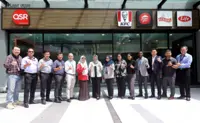Through SIMM, fibre-optic sensing technology is being deployed in various settings for clients in the public and private sectors, including construction, oil and gas, and infrastructure and asset monitoring projects.
FIBRE-OPTIC technology is often associated with transforming the telecommunications industry.
These strands of glass fibres have changed the way we communicate, network and consume information and entertainment.
By allowing data to be transmitted over long distances and increasing internet speeds, fibre-optic technology has led to the development of new communication technologies, cloud-based communication tools and enabling the streaming of high-definition videos.
Beyond the telecommunications industry, sectors such as medicine and industrial automation have also benefited from fibre-optic technology.
In recent years, advancements in fibre-optic sensor technology are offering civil engineers an alternative for performance monitoring of civil infrastructures.
This is a key focus of the research and consultancy services offered by the Smart Infrastructure Modelling and Monitoring Centre (SIMM) at Universiti Teknologi PETRONAS (UTP).
A research centre within the Institute of Transport Infrastructure, SIMM focuses on underground infrastructure, wireless communications, scientific computing and sensor technology.
It is in the latter, thanks to advancements in fibre-optic technology, that UTP sees tremendous promise for the civil engineering and construction fields – from ensuring that new construction projects adhere to building and environmental codes and requirements to the structural performance monitoring of existing infrastructure such as roads, bridges, tunnels and slopes.
Head of SIMM, Associate Professor Dr Hisham Mohamad says fibre-optic sensor technology addresses many of the limitations of conventional monitoring instruments.
“Conventional monitoring tools have limitations as they are based on electrical sensors which are prone to measurement errors, noise and reliability issues,” he says.
The use of traditional monitoring instruments has its pitfalls including electromagnetic interference, limited sensing range and that it requires numerous cable installations.
Advancements in optical fibre sensing technology, particularly the advent of distributed fibre-optic sensing, are therefore a game-changer.
Distributed fibre-optic sensing technology – made up of distributed temperature, distributed strain and distributed acoustic sensing technologies — enables continuous, real-time measurements along the entire length of a fibre-optic cable, overcoming the limitations posed by conventional sensors that rely on discrete sensors measuring at predetermined points.
“We’re now using fibre-optic technology to measure various engineering parameters such as temperature, vibration, strain and displacement. With fibre-optic sensing technology, we can see how a structure behaves as well as understand the health and lifespan of our buildings, tunnels, railway tracks and bridges, just to name a few.
“Distributed sensing, for example, enables us to measure temperature and strain along the entire length of the cable, whether it’s placed along a gas pipeline, railway track or fences, as well as detect breakages and monitor third-party intrusions,” he says, adding that the data are sent to the cloud where it is processed.
He points out that advances in strain measurement using fibre-optic technology also present new opportunities for monitoring the performance of geotechnical structures during and after construction.
Conventional strain measurement approaches, he adds, are beset with several issues including various instrumentation problems and data accuracy.
Employing distributed fibre-optic sensing technology does not overcome these limitations but offers new opportunities for the construction industry.
Installing these sensors on concrete piles for new builds gives engineers and builders a continuous strain profile, which allows them to determine the pile and foundation profile, improve building design and achieve cost efficiencies.
In older buildings slated for redevelopment, the technology can also be used to determine the structural health of the existing foundation.
“Fibre-optic technology offers a future for many things,” says Hisham. The advantages aren’t just seen on paper. Through SIMM, fibre-optic sensing technology is being deployed in various settings for clients in the public and private sector including construction, oil and gas, and infrastructure and asset monitoring projects.
“Some of the centre’s clients to date include PETRONAS, UEM Edgenta, PLUS, Gamuda and the Public Works Department.”
Apart from the university’s track record of collaboration with PETRONAS in pipeline monitoring and predictive analytics for asset maintenance, UTP’s research facilities are also on par with some of the top global research institutes.
“We have cutting-edge equipment as well as technicians to manage the labs and a pool of researchers and engineers to support the consultancy work,” says Dr Hisham.
“At our centre, we have civil engineers who understand the problems in construction and structural conditions, so we know what’s required. We also know the limitations of conventional instruments and the advantages of fibre-optic technology. We’re able to carry out wireless monitoring, live monitoring and even cloud-based monitoring, these are all very new developments,” he says.
Besides having researchers who are academically sound, UTP also takes pride in its globally recognised expertise.
Hisham, for example, is an expert in fibre-optic distributed sensing and has been involved in construction monitoring projects such as monitoring tunnel deformation at London King’s Cross and Singapore’s Mass Rapid Transport Circle Line.
Before joining UTP in 2015, he was at the Geotechnics Division at the Belgium Ministry of Mobility and Public Works for a year and was involved in monitoring ground excavation and construction projects of the world’s largest shipping lock in Antwerp.
Beyond the singular expertise of its researchers, UTP’s research and consultancy services benefit from a collaborative working environment among the various research institutes, which allows UTP to undertake projects of a multi-disciplinary nature and offers a suite of solutions to its clients and partners.
“We collaborate with other research institutes at UTP to produce a whole package of solutions, from developing sensors and applications right through to their deployment in the field and the real-time processing of the data.”
For more information on fibre-optic technology solutions and opportunities, email us at consultancy@utp.edu.my and visit www.utp.edu.my.







